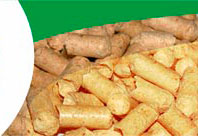Combined torrefaction and pelletisation
Densification by means of pelletisation is considered to be a proven technology to improve biomass properties for its conversion into heat and power. The current production volumes (world wide) that exceed 5 Mton/a, indicate that the biopellets (or wood pellets) market is becoming quite mature with serious outlets in the domestic market (heating) and the energy market (heat and power). Although a relatively small volume of biopellets is produced in the Netherlands, the Dutch energy sector is consuming a considerable amount through co-firing in coal-fired power stations. In fact, biopellets are the state-of-the-art sustainable fuel to replace coal, which must be roughly 6 Mton/a of coal in 2008-2012, according to the policy agreement between the Dutch government and the Dutch energy sector.
However, biopellets are expensive, require special treatment at the power station and cannot be produced from a wide variety of biomass feedstock. ECN has introduced an alternative process for the production of biopellets. This process is based on a combination of torrefaction with pelletisation and is called the TOP process for the production of TOP pellets. The TOP process integrates the advantages of both processes with respect to the quality of the biopellet. Since the earlier development of the TOP process involved only initial desk studies, this work aimed for the proof-of-principle phase of its development and involved experimental evaluation of torrefaction combined with densification (pelletisation), conceptual design, and an economic analysis of a biomass to electricity production chain based on the TOP process. The experimental work revealed that TOP pellets may have a bulk density of 750 to 850 kg/m3 and a net calorific value of 19 to 22 MJ/kg as received. This results in an energy density of 14 to 18.5 GJ/m3. The energy density is significantly higher than conventional biopellets produced from softwood (sawdust: 7.8 to 10.5 GJ/m3). In contrast to conventional biopellets, the experimental tests revealed as well that TOP pellets can be produced from a wide variety of feedstock (sawdust, willow, larch, verge grass, demolition wood and straw) yielding similar physical properties. From tests on the water uptake and mechanical strength of both TOP pellets and conventional pellets, it is concluded that TOP pellets have a largely improved durability. It is expected that the TOP production process can be operated with a thermal efficiency of typically 96% or a net efficiency of 92% on LHV basis. The TOP process requires a higher total capital investment compared to the conventional pelletisation process, respectively 5.6 M? against 3.9 M? for a capacity of 170 kton/a of sawdust feedstock with 57% moisture content. However, the total production costs of the TOP process expected to be lower, 2.2 ?/GJ against 2.6 ?/GJ for conventional pelletisation. Furthermore, the costs advantages of TOP pellets amount approximately 30% in logistic operations using the same infrastructure as used for conventional biopellets. This is the result of the higher bulk density of TOP pellets and the lower tonnage that needs to be transported (per GJ). For a market price of 7.3 ?/GJ of biopellets the internal rate of return of the TOP process is 30% against 13% for conventional pelletisation. Under these conditions the payout periods are respectively 3 and 6 years. From the above it is concluded that a high economic potential exists for the TOP process. The major possible savings in biomass-to-energy chains are of such nature that the economics of this new technology are attractive for the pellet producers, pellet consumers, but also the governmental organisations to stimulate sustainable energy production. The ECN TOP technology enables the production of biopellets from biomass that is more expensive or from biomass for which it is currently infeasible. On the longer term, TOP technology can contribute to a considerable and justified reduction of subsidies on green electricity, but this must be considered in close relation to the biomass feedstock prices, costs of logistics (especially sea transportation) and the general trends in energy market prices. It is recommended to continue the development of ECN TOP technology through pilot scale testing of the identified technology.
Any copying and distributing the material of Ukrainian Biofuel Portal
without active hyperlink is stricly prohibited !
Link to this news: Combined torrefaction and pelletisation
Copy & Paste This Code to your website:
Views: 6566 Added: 25-06-2008
Average Rating:
Combined torrefaction and pelletisation







